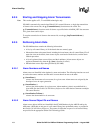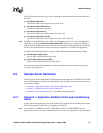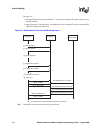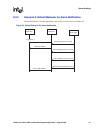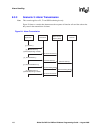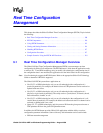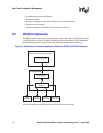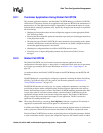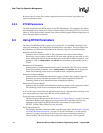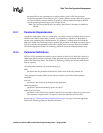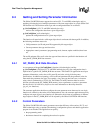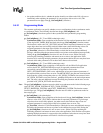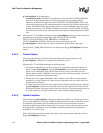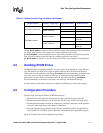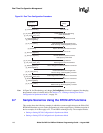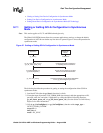
112 Global Call API for HMP on Windows Programming Guide — August 2006
Real Time Configuration Management
the target object is located. The customer application must ensure that the target object and
requested parameters match.
9.2.3 RTCM Parameters
The third component of the RTCM feature are the RTCM Parameters. The parameters are defined
and maintained in four categories of software modules: Global Call Library (GCLib), Call Control
Library (CCLib), Protocol and Firmware. Each software module supports different target objects as
well as the target objects’ parameters.
9.3 Using RTCM Parameters
The Global Call RTCM provides a generic way of getting (E1, T1 and ISDN technologies) and
setting (all technologies) the configuration information for a target object. The target objects and
their parameters are defined and maintained in the following categories of software modules:
Parameters in GCLib Module
parameters that are defined in GCLib. These parameters are common across multiple
technologies, such as protocol name and ID, call event mask, and the call state mask of a line
device. Although the GCLib module maintains many of the GCLib-defined parameters, some
parameters, such as calling number and call info, are maintained in other modules (such as
CCLib).
Parameters in CCLib Module
parameters that are defined and maintained in the CCLib module. The CCLib may maintain
some GCLib-defined parameters, such as calling number and call info. See the appropriate
Global Call Technology Guide for more information about configurable parameters.
Parameters in Protocol Module
parameters that are defined and maintained in a protocol module. One example of protocol
parameters are country dependent parameters (CDP). See the appropriate Global Call
Technology Guide for more information about configurable parameters.
Parameters in Firmware Module
parameters that are defined and maintained in a firmware module. See the appropriate Global
Call Technology Guide for more information about configurable parameters.
To access the value of a parameter, the application must specify a four-part name consisting of two
pairs: (target object type, target object ID) and (set ID, parameter ID).
Target object type and target object ID
This pair represents the target object. See Section 1.5.4, “Target Objects”, on page 25 for more
information. Both the target object type and target object ID are specified as the first two
arguments to the Global Call RTCM API function. An example of a target object is
(GCTGT_CCLIB_CHAN, Global Call line device ID).
Set ID and parameter ID
This uniquely represents a parameter within a specified target object. See Section 9.4, “Getting
and Setting Parameter Information”, on page 114 for more information. A set ID typically
represents a group of parameters that are closely related and are maintained in the same
software module. The parm ID represents a parameter within a given set ID. In general,



